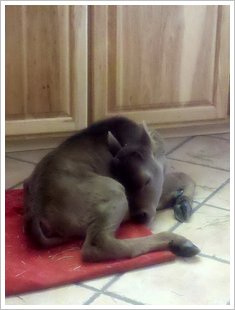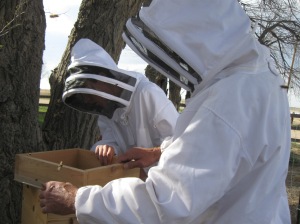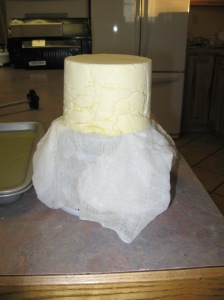Filed under: Cheese & Other Dairy Products, Cows | Tags: butter, cultured butter, Jersey cow, raw milk
Some readers have been wondering what I’ve been up to lately. Well, here you go! I’ve been making cultured butter and lots of it. Tiddles gives us about 5 gallons of milk a day and making butter is one way to use it all up.
Cultured butter can be made by adding a store-bought culture to the cream but it can also be made the old-fashioned way of using cream that has been allowed to sit at room temperature for 1-2 days. The advantage of the store-bought culture is that you control what bacteria is predominant in flavoring the cream. The advantage to the old-fashioned way is that it’s quick, easy and cheap. I have been quite pleased with the results of the latter method so that is what I have been using.
Here is how I do it:
- skim cream into a separate bowl and chill
- add cream to food processor, and using the bread dough blade, process until the butter breaks
- line a sieve with cheesecloth or butter muslin and dump the butter and butter milk into the sieve
- allow the buttermilk to drain away from the butter for a few minutes
- wash the butter under cold running water and add salt to taste (if desired)
- form the butter using a mold or by hand and store
That’s it. Simple as can be and really tasty!
Sometimes you have to laugh if you don’t want to cry. Tiddles, our recently freshened Jersey cow, was diagnosed with ketosis last Wednesday. She had quit eating her grain about two weeks before that but I thought that cows knew what they needed to eat instinctively and she was still eating plenty of hay, so I dismissed it. That was my first mistake. A few days later, I noticed that her milk production seemed to drop and that the milk smelled funny. I was the only one who smelled it, though, and she was producing so much milk that I was making lots of cheese just to keep up, so I dismissed it. That was my second mistake. Last Sunday, I noticed that her breath had the same funny smell her milk did and she wasn’t eating very well. I made a mental note that when I wasn’t so busy I needed to look up ketosis. I had a faint memory of reading up on it before she had her calf. Unfortunately, I was still busy and it wasn’t until Wednesday that her condition had deteriorated to the point where I thought I had to call the vet. While I was waiting for a call back, I went back through my book and Tiddles’ was a classic case. When I went out to feed her and milk her, she looked like a cow from India–emaciated. She walked with a bit of a limp, too, but I couldn’t see any injury. She had been a bit listless and she’s usually a very curious, active cow. She greets strangers and will follow you around the corral or out into the pasture like a big, ungainly dog.
For my readers that didn’t open the link to the official definition of ketosis, think of it as a metabolically induced anorexia. The cow starts to suddenly use her fat reserves as her sole source of energy. She loses her appetite for everything, not just grain. Ironically, the thing she needs most is carbohydrates—-lots of them—-right now! So the treatment is to inject her daily with Vitamin B Complex, force feed her a molasses brew until there is no more trace of ketones in her urine, which brings us to the part where we can laugh.
I am a member of the “Keeping a Family Cow” yahoo group and while I was waiting for the vet to call back, I was pestering my fellow group members for help. They told me to go get ketone test strips and to test her urine twice a day to gauge when I needed to force feed her the molasses brew and when just the injection of B Complex would be sufficient. I was already almost in tears thinking that I should have acted much sooner and here I was pondering the idea that I would have to stare at my cow all day, armed with a test strip waiting to catch her pee. Isn’t that pitiful? And then I read that you can actually make a cow pee on demand by rubbing her briskly just below her vulva. So out to the barn I went, armed with ketone strips and my newly acquired knowledge to give Tiddles a massage. I felt a little awkward. I don’t know, call me puritanical, but rubbing around animals’ privates is a wee bit on the perverted side, isn’t it? But I carried on and a few seconds later she went into the characteristic squat of a cow about to urinate. I stopped the massage and stuck my test strip into the stream and voila! Urinalysis complete! So if I ever join the circus, I am now armed with the most amazing trick, don’t you think?
So I think I’ve learned my lesson now. The next time she calves I’ll be watching her like a hawk. I might just feed her some Snickers to keep her sugar up (kidding!) prophylactically. I have been told that once they get ketosis, it is a long road back to optimum bovine health and that I am looking at weeks, not days, of giving shots until she is back to normal. Anybody who reads this blog knows that I *hate* giving shots. So if you’re the praying type, pray for the City Girl Farmer. She is very unhappy at her lot right now and she will be suffering a little bit each day until Tiddles is back to her old self.
Filed under: Cheese & Other Dairy Products | Tags: cheese, cheese making, cheese press, Reblochon
One of my neighbors kindly built me a cheese press since that is what was really holding me up from making more hard cheeses. The followers are too tall, so I ended up substituting some canned food and a book. I made a Gouda a couple of days ago which is happily aging for a week before it gets waxed and off to age some more.
Today, I finally found a recipe for Reblochon, which is a cheese I had in France and found absolutely fabulous. Recipes for making Reblochon are surprisingly hard to come by. Both the American and French search engines return results on how to use Reblochon in a recipe, not a recipe for the cheese. Anyway, I found a cheese forum, filled with cheese experts and intimidating information, on which there was a recipe. I can tell I lack sophistication, so I just thought I’d print the recipe and give it a go. I don’t have the tools to test the pH at different times during the process. If it doesn’t end up tasting like Reblochon, I’ll just rename it and maybe start something new. 🙂
The call finally came and last Saturday was the day. The Green Bee Co. is a (somewhat) local company that rescues bees from people who don’t want them and re-homes them to people who do. The proprietor, Buz (yes, that’s his real nickname which actually preceded his interest in bees), and his wife, Cathy, came out to help Thomas get them into the hive. This involved cutting pieces of the comb and attaching them to Thomas’ foundation and then, once his hive was ready, dumping the bees into their new home. Apparently it was a very healthy, thriving colony.
After Buz tapped the box twice to send the message to the bees that it was time to get out they got understandably agitated. I was standing about 15 feet away and some of them came over and attacked me. I was stung about a dozen times before someone was able to wave them all off. Thomas and Buz who were right at the epicenter were unharmed. We don’t know why they didn’t like me. Could be because I wasn’t wearing white. I had been fighting a cold and there was some speculation that the essential oils I had been using were disagreeable. I came into the house where we iced all the stings, applied lavender to them and I began my descent into a Benadryl induced haze. I was pretty much unconscious for the following two days because of the massive quantities of the drug I was taking. I avoided a trip to the emergency room, though, and did not have to pull out the EpiPen!
We are in the middle of a snow storm (yes, I know it is the middle of May) and Thomas has checked them several times. All seems to be well in the bee world. Not that I have any first-hand knowledge of that fact! For the time being, I’m content to take his word for it.
Filed under: Cows | Tags: calving, dairy calf, Jersey calf, Tiddles' bull calf
I could tell she was getting close. I think the definitive sign is how they walk—-or more accurately, can’t walk. That’s how you know you are less than a week away, in this case about 3 days. Plus, we were expecting a spring snow storm and that seems to be the favorite time for livestock to give birth. I guess if they survive the cold and wind, Old Bitch Nature (my favorite little nugget from the Contrary Farmer) figures they can survive anything! I could tell she was in labor Tuesday night at milking time so I decided to wait up with her and watch. I was not disappointed! A healthy bull calf was born around 12:15 a.m. Wednesday morning (April 27th). The birth was uneventful but still a little miracle as every birth is.
It took him a really long time to nurse which was of some concern. That sent me in to take a look at the internet and I picked up some interesting information. Dairy breeds have been bred to have HUGE udders and their teats are not tucked up in the natural place that calves look for the food source, high up between the mama’s back legs. Tiddles’ teats were hanging down below her hocks so they were hard for him to find and latch on to. Some smart agricultural expert had a little table of how low cows teats are and how long it takes on average for the calf to find them. The lower they are, the harder it is for the calf. Who knew?
I also discovered that the calf’s ability to absorb all the antibodies from colostrum goes down the longer it takes to nurse, so that if it doesn’t get colostrum until 48 hours after it is born, it only absorbs 5% of the antibodies. That was enough information to get me worried. We hadn’t got him to latch on really well by 4:00 a.m., so he has been bottle fed since then.
I am posting pictures (mostly so I can refer back) so if you are squeamish about these things, you’ll probably want to stop after this bit of text.
Filed under: Weather

I was reading the Farmer’s Almanac last year in which I learned that Ember Days were used to predict the weather for the succeeding season. Ember Days are part of the ancient western Christian liturgical calendar and they were penitential days that corresponded more or less with the change of season. I recorded the weather on last year’s winter Ember Days and on this spring’s Ember Days and it is not looking good for water if the predictor is true.
And just out of the blue the other day, a friend told me her mother said that potatoes needed to be in the ground by Good Friday. Yikes! I’ve got to get busy with that garden!
I find the gardening sources that make reference to religious feast days quite fascinating. I’d like to get hold of a monastic gardening book. Any of my readers know of one?
Filed under: Cows
The heifer calf was born on a beautiful late January day, a teaser, a taste of spring. Unfortunately, our worst winter days (so far) were right on its heels. As my son and I were struggling to milk the unmilkable cow, and had gone to pick up a milking machine loaned to us by the owner of Dallas Dome Dairy, the new calf was shivering uncontrollably in the frigid temperatures we were experiencing. So we brought her into our kitchen to stay warm while the storm passed. I’ve heard from a couple of more experienced farmers that this is not at all unusual. For some reason the mothers give birth at the worst possible weather times and I have since heard stories of calves, lambs and kids in laundry rooms, in the oven, near the stove, etc. so that their owners could rescue them from the elements.
- Celebrating the birth of a calf with a cigar and a martini
- Snuggling up to a baby cow
- Relaxing after milking her mama
- Giving the baby her morning bottle
I have made soft, easy cheeses with success but for some reason I found hard cheeses more intimidating. Reading a cheese recipe is like reading a recipe for soap or beer or wine. It dawns on you that some really complex chemical interactions (magic for an unscientific person like me) are required for your cheese (beer or wine) to come out right. You have to pay attention to things like acidity! *shudders as science angst grips her stomach*
I decided that I had to face the giant and all that I really had to lose was a couple of gallons of milk, some rennet and some culture (pun intended). It had been a long time since we had chicken enchiladas and I decided to make some queso fresco for them instead of buying the cheese at the store.
After completing the first magic step of turning milk into queso fresco-flavored curds, it was time to press the cheese. I used to think that pressing cheese was necessary just to turn it into that nice cylindrical shape that made it easier to store. I learned that it, too, is another magical process. Cheese needs to be pressed so that it chemically “knits” together. Who knew? I had too many curds for my press capacity, so thanks to my neighbors at Victory Ranch, I was able to improvise a press with a mold, a souffle dish and some heavy books. I recommend the standard press.
I discovered you don’t really need to understand how everything works in order to make cheese. Just follow the instructions of a good recipe and all the chemistry will take care of itself.
How did it taste? Like queso fresco, only as with all the other things that are home grown, it was somehow richer. Like the difference between home-made brownies and brownies out of the box. Raw milk aficionados will understand what I’m talking about.
This, my friends, is why a person would keep a dairy cow.
Poor Rosie. The day she calved her udder was so full the milk just dripped and sometimes sprayed out of her. Her skin was stretched so tight that I thought it would tear. Her udder looked like a blown up rubber glove with the teats pointed outward. She was so full we could only get a thumb and a forefinger on each teat and because they pointed away from her center, we had to milk one at a time. We were milking about a half gallon at a time out of a cow who was producing about 2 1/2 gallons of milk twice a day. Two days after she calved we had her in a stanchion for 5 hours trying to milk her.
The next day we reached our record cold temperatures for the year. (I hope anyway!) The high that day was -7 and the low -16 and the wind was howling at about 25-30 miles an hour. The guy we bought our cow from just happened to be in Colorado and just happened to call to see how everything was going. He offered to loan us a milking machine, and while I had been reluctant to use a milking machine, I decided to take him up on his offer. That is the smartest decision I’ve made in recent history. We drove 2 hours one way to where he was to pick up the machine, came home and milked out the cow. It took three people to work the machine but we made it happen and we did it again the next morning.


We brought the new calf into our kitchen because we don’t have the facilities to maintain calves at a toasty 40 degrees when the weather is like that.
We are continuing to keep her warm in our kitchen as the temperatures have been below zero and in the single digits at night, but we’re looking forward to relocating her tomorrow when we expect to have low temperatures in the 20’s. I really need to be convinced about this global warming thing…












